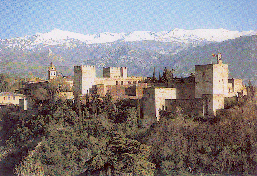LA CIUDAD DE GRANADA
/ THE CITY

Granada contabiliza cerca de trescientos mil habitantes,
pero son muchos más los que, viviendo en poblaciones del
entorno, interaccionan habitualmente con la ciudad. Sus alrededores,
además de testimonio de importantes asentamientos prehistóricos,
muestran huellas de fenicios, iberos, romanos, visigodos y árabes.
Pero, sobre todo, está condicionada por haber sido el último
reducto del Islam en Europa occidental; el Reino de Granada,
fundado tras la descomposición del califato de Córdoba,
perduró hasta su conquista por los Reyes Católicos
en 1492. Este hecho se refleja en la estructura urbana y en sus
construcciones, donde la influencia árabe coexiste deliciosamente
con la renacentista y barroca para inspiración y gozo de
artistas, intelectuales y viajeros, justificando así el verso
"Dále limosna, mujer, que no hay en la vida nada como la
pena de ser ciego en Granada".
Su situación geográfica es también notable.
Emplazada en una amplia vega determinada por los ríos Genil,
Darro y Beiro, descansa junto a colinas que albergan los singulares
barrios Sacromente y Albayzín, éste "Patrimonio
de la Humanidad", y los palacios y jardines de la Alhambra
y Generalife que hablan todavía del mayor esplendor
alcanzado en el siglo XIV. La ciudad, en el piedemonte occidental
de Sierra Nevada, dista 36 kilómetros de la estación
de esquí más meridional de Europa, con pistas en tre
los 2000 y 3400 metros de altitud, y dista 70 kilómetros
del mar, donde se configuran 80 kilómetros de Costa Tropical
o Costa del Sol granadina con agradables playas. La proximidad
de la fragosa zona montañosa de la Alpujarra, y de
interesantes poblaciones como Alhama, Guadix y Baza
conforma una variada e interesante región. El clima en la
ciudad, entre 669 y 782 metros sobre el nivel del mar, es seco y
aireado, con temperaturas medias máximas de 40ºC y mínima
de 5ºC, y 15ºC de media anual.
Otros atractivos se siguen de la hospitalidad de sus gentes, del
ambiente estudiantil, que impregna lugares y actos, de su moderna
infraestructura hotelera, y de su vitalidad cultural. En este sentido,
juegan un papel sobresaliente la Universidad, los Festivales Internacionales
(Música y Danza, Teatro, Jazz,...), las fiestas locales,
y el Palacio de Congresos y Exposiciones.
La ciudad, a 430 kilómetros de Madrid, a 166 de Córdoba
y a 250 kilómetros de Sevilla, está servida por su
propio aeropuerto, a 15 kilómetros, y por el aeropuerto internacional
de Málaga, a 128 kilómetros.
Granada contains approximately three hundred thousand inhabitants,
although those living in nearbi towns regularly use the city's
resources, thereby increasing numbers. Aside from being a testimony
to important prehistoric settlements, Granada's surroundings reveal
traces of Phoenician, Iberian, Roman, Visigothic and Arab civilization.
Above all, the city is characterized by having been the last bastion
of Islamic power in Western Europe. The Kingdom of Granada, founded
after the collapse of the Caliphate of Cordoba, lasted until its
conquest by the Catholic Kings (Ferdinand and Isabel) in 1492.
These events are reflected in the city's urban structure and its
buildings, in which the Arab influence exists side by side renaissance
and baroque architecture in often delightful combinations, acting
as the inspiration and enjoyment of artists, intellectuals and
travellers. The city's attraction indeed justifies the famous
verse: "Spare him some charity lady, for there is nothing in this
live worse than the pain of being blind in Granada."
Also worthy of mention is Granada's geographical location. Situated
in a wide plain (the vega) formed by the rivers Genil, Darro and
Beiro. The city is surrounded by adjoining hills where the unique
districts of the Albayzín and Sacromonte
can be found, as well as the gardens and palaces of the Alhambra
and the Generalife, buildings of great cultural heritage
that still speak to us today of the artistic splendour of the
ourteenth century. Located on the western slopes of the Sierra
Nevada, Granada is furthermore only 36 kilometres from the most
southerly ski resort in Europe, with slopes between 2000 and 3400
metres in height. It is likewise only 70 kilometres from the sea,
in which can be found the attractive beaches of the Costa Tropical
and the Costa del Sol stretching for 80 kilometres along
the coastline. The rough mountainous lands of the Alpujarra
on the one hand, and the appealing towns of Alhama, Guadix
and Baza on the other add to make the region varied and
interesting. Granada, situated between 669 and 782 metres above
sea level, has a dry, fresh climate, with average maximum and
minimun temperatures of 40ºC and 5ºC respectively, 15ºC representing
its average temperature throughout the year.
Other pints of attraction can be found in the hospitality of its
people, its lively student atmosphere seen throughout the city's
places and events, its modern hotel network, and its vibrant cultural
life. The latter is best reflected by the University, the International
Festivals (Music and Dance, Theatre, and Jazz,...), local public
fiestas and the Palacio de Congresos y Exposiciones
The city, situated at a distance of 430 kilometres from Madrid,
166 kilometres from Cordoba and 250 kilometres from Sevilla, is
served by its own airport, 15 kilometres away from the city centre,
and Malaga's international airport, 128 kilometres away.
Para más información, contactar:
/ For more information, contact:
(prefijo provincial / domestic province code:
958,
prefijo internacional / international code: + 34-58)
Oficinas de Turismo / Tourists Offices:
|
- Plaza Isabel la Católica 1,  227
514 / 513 / 520; 227
514 / 513 / 520;
- Plaza Mariana Pineda 12,  226
688 / 223 527; 226
688 / 223 527;
- Calle Libreros 2,  225
990; 225
990;
- Plaza del P. Suárez,  221
022. 221
022.
|
Excelentísimo Ayuntamiento de Granada
/ Town Hall:
- Plaza del Carmen 5,  227
568 / 489 / 248 100 227
568 / 489 / 248 100 |
Cámara de Comercio, Industria y Navegación
/ Official Board of Commerce:
- Calle Paz 18,  263
504. 263
504. |
- Más información / More information:
|

